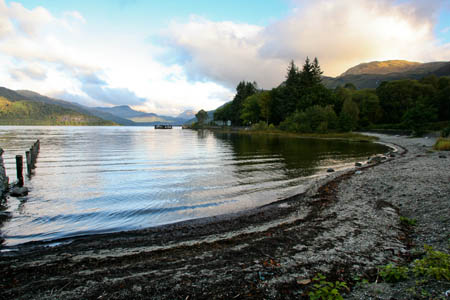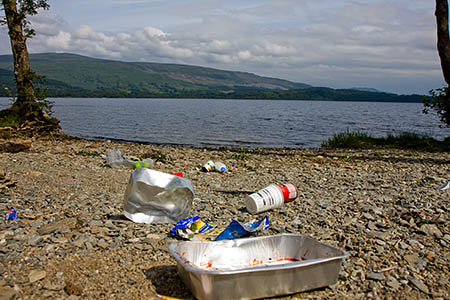The owner of a pub on the shore of Loch Lomond said visitors are returning to the area for the first time in 30 years after a wild-camping ban was introduced to curtail antisocial behaviour.
Sandy Fraser of the Oak Tree in Balmaha said he had been thinking of selling up before the national park authority brought in bylaws to ban unauthorised camping along the east banks of the lake.
The Loch Lomond and the Trossachs National Park Authority said the controversial ban on a stretch of Scotland’s most popular long-distance walking route, the West Highland Way, had reduced problems in the area.
The authority’s board heard that there have been significant reductions in antisocial behaviour reported to the police, litter and damage to the environment.
Kevin Lilburn, chair of the East Loch Lomond Management Group said: “Previously we suffered some sort of incident at my home pretty much every weekend in the summer, including litter, theft, vandalism and verbal or even physical intimidation.
“Since the bylaws have been introduced, there have been none. Not one.
“That speaks for itself and official statistics tell a similar story. We have gone from a situation where my neighbours and I dreaded sunny days to one in which we can relax, enjoy where we live, and happily share the area with responsibly behaved visitors.
“This hugely positive change came about because we, as a community, brilliantly supported by the national park authority, brought together decision-makers from all the key agencies such as Police Scotland and the Forestry Commission, shared concerns and constraints, listened to each other’s points of view and then came up with workable solutions.
“The whole process was a shining example of what can be achieved when a community is able to work closely with responsive and supportive public agencies and present a united front.”
The bylaws, brought in in 2011, mean a possible £500 fine if anyone is caught camping outside designated official sites along a 17km (10-mile) stretch of the West Highland Way between Drymen and Rowardennan.
Their imposition was opposed by Ramblers Scotland, which described them as an excessive reaction to problems on the east shore of the loch.

Antisocial behaviour has been reduced on the east side of Loch Lomond
They were also concerned the camping ban could spread to other areas. Under the Land Reform (Scotland) Act, responsible wild camping is allowed throughout the Scottish countryside.
Oak Tree Inn owner Sandy Fraser said: “For us, since the bylaw was introduced we’ve seen a much wider variety of visitors to the area.
“Some have even told us that they’re returning after 30 years away. All in all it’s been good for business. Before the bylaw was brought in, we had been considering selling up as we’d had enough.
“We wouldn’t have built the tea-room or the shop. But now we are expanding the business to cope with the increased demand from visitors looking for a quality experience.”
The park authority said other areas also suffer from the negative impacts of overuse and antisocial behaviour.
It said these are currently tackled with ongoing education, ranger and police patrols.
“Despite this considerable effort and investment, these problems continue to spoil the visitor experience at the most popular loch shore sites,” a spokesperson said. “As a result, the national park authority will be talking to communities, landowners, visitors, recreation groups and interested parties to hear their views on the extent of these issues and the possible solutions.”
National park chief executive Fiona Logan said: “With the invaluable support of the local community, the camping bylaw on east Loch Lomond was introduced as part of an extensive package of measures to tackle long standing problems from visitor pressure.
“Despite years of educational activity, rangers working with visitors, our high profile Respect the Park campaign and collaboration with police services, the visitor experience in this area was still being spoiled by the antisocial behaviour of some and, at peak periods, the sheer volume of visitors to the area.
“Scottish ministers asked for a report on the situation after three years of operating the byelaw. The paper put before our board yesterday shows that there have been significant changes since the bylaw was put in place.
“Right now we are in listening mode, in the very early stages of considering the extent of these park-wide issues and possible solutions for each individual area.
“We are already heavily investing in new facilities in conjunction with our partners and the private sector to extend and improve the experience for visitors to the park.
“A great example of this is the development of the Sallochy Bay campsite, and at Loch Lubnaig.
“At the end of the day, we want to ensure that all visitors and residents of the park have a great experience and that our scenic loch shores are protected and enhanced for generations to come.”

OutdoorsAndy
25 March 2014One size fits all law, stops all for the usual minority messing it up for others!
It’s hard to argue with the above article though, but it would seem that the law was broken by people by littering etc. and was simply not enforced, (or perhaps enforceable).
As a responsible Scottish wild camper, its a worrying trend, especially given that estate owners would have us all banned, (with some famous examples of hostility- eg Glen Lyon etc).
However, Lock sites are getting abused. Perhaps there should be a ban on all road side/lock side camping to within a certain distance- far enough to put off the louts?
At the end of the day, litter and abuse is an issue, but to destroy access rights is always a bitter pill for me to swallow, given they are such a precious thing!